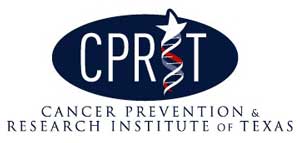The University of Houston (UH) received a $2.4 million grant to fund the most promising
young cancer researchers who are working at the cutting-edge of a new multidisciplinary
approach to fighting cancer.
The award is part of the latest round of grant disbursements from the Cancer Prevention and Research Institute of Texas (CPRIT), which oversees the state’s new billion-dollar war on cancer. It is UH’s second CPRIT grant, and the first in the science and engineering fields.
The money will fund postdoctoral scientists at UH whose research combines cancer biology with computational disciplines like computer science, theoretical physics or chemistry. The grant builds on UH’s existing collaborations with the Texas Medical Center (TMC) within the Keck Center for Interdisciplinary Bioscience, which will help administer the program.
New science Ph.D. graduates typically complete a two year or more postdoctoral program before starting research careers in academia, government or industry. The CPRIT postdoctoral researchers in this new program will have two faculty mentors – one in a computational field and one in cancer biology – chosen from UH, Baylor College of Medicine, Rice University, UT Health Science Center, UT Medical Branch Galveston or the M.D. Anderson Cancer Center.
 “There’s a realization that all the problems of cancer won’t be solved by biology,”
said B. Montgomery Pettitt, Hugh Roy and Lillie Cranz Cullen Distinguished University
Professor and director of UH’s CPRIT training program. “We need to bring the expertise
in a wide variety of fields to bear on these problems, because the most revolutionary
stuff comes from thinking at the interface of disciplines.”
“There’s a realization that all the problems of cancer won’t be solved by biology,”
said B. Montgomery Pettitt, Hugh Roy and Lillie Cranz Cullen Distinguished University
Professor and director of UH’s CPRIT training program. “We need to bring the expertise
in a wide variety of fields to bear on these problems, because the most revolutionary
stuff comes from thinking at the interface of disciplines.”
Beginning in September, one dozen postdoctoral trainees will be chosen. The program also will provide summer research opportunities for about 20 undergraduates. The cross-disciplinary nature of the program will, for example, allow a computer science postdoctoral researcher to work in a cancer biochemistry lab. Conversely, a biochemist can work in a programming and applied mathematics lab to understand and enhance computational tools against cancer.
“By gaining proficiency in a second technical area, these researchers will be equipped to tackle some of the most pressing problems in cancer research,” Pettitt said. “For example, a scientist studying genes to understand biochemical pathways in cells may find existing technology inadequate to piece together the giant puzzle of data produced by genetic sequencers and must work with computer scientists to produce new computational tools.”
These sorts of collaborations are already thriving among researchers at UH and TMC. In one project highlighted as a model of future collaborations, Ioannis Kakadiaris, Eckhard Pfeiffer Professor of Computer Science at UH, is working with a team at M.D. Anderson and UT Health to improve the effectiveness of chemotherapy through better imaging methods.
The so-called “leakiness” of a tumor’s microvasculature network can determine how susceptible a tumor is to cancer drugs. However, existing computer imaging cannot precisely characterize a tumor’s vascular leakiness. So, Kakadiaris and his team are developing diagnostic tools that will not only measure a tumor’s vulnerability to drugs, but also predict the outcome of treatment options. This will provide patients more personalized treatment and help avoid futile or ineffective treatments.
“The CPRIT award underscores UH’s growing role in biomedical research,” Pettitt said. “There likely will be more such grants in the future as the university’s science and engineering expertise complements TMC’s clinical expertise. The award puts UH with the leading research institutions in Texas receiving CPRIT funding and also boosts UH by adding more postdoctoral researchers, an important indicator for Tier-One status.”
The first CPRIT grant awarded to UH was valued at nearly $275,000 for a cervical cancer education initiative that measures cancer awareness among Vietnamese women. Jenny Yi, associate professor in UH’s department of health and human performance, was the recipient of that two-year grant, which is aimed at preventing cervical cancer in Houston’s Vietnamese community. Yi says Vietnamese women have an incidence rate four to five times higher of cervical cancer than do white women.
The two CPRIT grants awarded to UH thus far are part of the $3 billion in cancer research that Texas voters approved in 2007 to be distributed over 10 years. The first batch of funded projects was announced in 2009.
About the University of Houston
The University of Houston is a comprehensive national research institution serving the globally competitive Houston and Gulf Coast Region by providing world-class faculty, experiential learning and strategic industry partnerships. UH serves 37,000 students in the nation’s fourth-largest city in the most ethnically and culturally diverse region in the country.
About the College of Natural Sciences and Mathematics
The UH College of Natural Sciences and Mathematics, with 181 ranked faculty and approximately 4,500 students, offers bachelor’s, master’s and doctoral degrees in the natural sciences, computational sciences and mathematics. Faculty members in the departments of biology and biochemistry, chemistry, computer science, earth and atmospheric sciences, mathematics and physics conduct internationally recognized research in collaboration with industry, Texas Medical Center institutions, NASA and others worldwide.
For more information about UH, visit the university’s Newsroom at http://www.uh.edu/news-events/.
To receive UH science news via e-mail, visit http://www.uh.edu/news-events/mailing-lists/sciencelistserv/index.php.
For additional news alerts about UH, follow us on Facebook and Twitter.
The award is part of the latest round of grant disbursements from the Cancer Prevention and Research Institute of Texas (CPRIT), which oversees the state’s new billion-dollar war on cancer. It is UH’s second CPRIT grant, and the first in the science and engineering fields.

The money will fund postdoctoral scientists at UH whose research combines cancer biology with computational disciplines like computer science, theoretical physics or chemistry. The grant builds on UH’s existing collaborations with the Texas Medical Center (TMC) within the Keck Center for Interdisciplinary Bioscience, which will help administer the program.
New science Ph.D. graduates typically complete a two year or more postdoctoral program before starting research careers in academia, government or industry. The CPRIT postdoctoral researchers in this new program will have two faculty mentors – one in a computational field and one in cancer biology – chosen from UH, Baylor College of Medicine, Rice University, UT Health Science Center, UT Medical Branch Galveston or the M.D. Anderson Cancer Center.
 “There’s a realization that all the problems of cancer won’t be solved by biology,”
said B. Montgomery Pettitt, Hugh Roy and Lillie Cranz Cullen Distinguished University
Professor and director of UH’s CPRIT training program. “We need to bring the expertise
in a wide variety of fields to bear on these problems, because the most revolutionary
stuff comes from thinking at the interface of disciplines.”
“There’s a realization that all the problems of cancer won’t be solved by biology,”
said B. Montgomery Pettitt, Hugh Roy and Lillie Cranz Cullen Distinguished University
Professor and director of UH’s CPRIT training program. “We need to bring the expertise
in a wide variety of fields to bear on these problems, because the most revolutionary
stuff comes from thinking at the interface of disciplines.” Beginning in September, one dozen postdoctoral trainees will be chosen. The program also will provide summer research opportunities for about 20 undergraduates. The cross-disciplinary nature of the program will, for example, allow a computer science postdoctoral researcher to work in a cancer biochemistry lab. Conversely, a biochemist can work in a programming and applied mathematics lab to understand and enhance computational tools against cancer.
“By gaining proficiency in a second technical area, these researchers will be equipped to tackle some of the most pressing problems in cancer research,” Pettitt said. “For example, a scientist studying genes to understand biochemical pathways in cells may find existing technology inadequate to piece together the giant puzzle of data produced by genetic sequencers and must work with computer scientists to produce new computational tools.”
These sorts of collaborations are already thriving among researchers at UH and TMC. In one project highlighted as a model of future collaborations, Ioannis Kakadiaris, Eckhard Pfeiffer Professor of Computer Science at UH, is working with a team at M.D. Anderson and UT Health to improve the effectiveness of chemotherapy through better imaging methods.
The so-called “leakiness” of a tumor’s microvasculature network can determine how susceptible a tumor is to cancer drugs. However, existing computer imaging cannot precisely characterize a tumor’s vascular leakiness. So, Kakadiaris and his team are developing diagnostic tools that will not only measure a tumor’s vulnerability to drugs, but also predict the outcome of treatment options. This will provide patients more personalized treatment and help avoid futile or ineffective treatments.
“The CPRIT award underscores UH’s growing role in biomedical research,” Pettitt said. “There likely will be more such grants in the future as the university’s science and engineering expertise complements TMC’s clinical expertise. The award puts UH with the leading research institutions in Texas receiving CPRIT funding and also boosts UH by adding more postdoctoral researchers, an important indicator for Tier-One status.”
The first CPRIT grant awarded to UH was valued at nearly $275,000 for a cervical cancer education initiative that measures cancer awareness among Vietnamese women. Jenny Yi, associate professor in UH’s department of health and human performance, was the recipient of that two-year grant, which is aimed at preventing cervical cancer in Houston’s Vietnamese community. Yi says Vietnamese women have an incidence rate four to five times higher of cervical cancer than do white women.
The two CPRIT grants awarded to UH thus far are part of the $3 billion in cancer research that Texas voters approved in 2007 to be distributed over 10 years. The first batch of funded projects was announced in 2009.
###
About the University of Houston
The University of Houston is a comprehensive national research institution serving the globally competitive Houston and Gulf Coast Region by providing world-class faculty, experiential learning and strategic industry partnerships. UH serves 37,000 students in the nation’s fourth-largest city in the most ethnically and culturally diverse region in the country.
About the College of Natural Sciences and Mathematics
The UH College of Natural Sciences and Mathematics, with 181 ranked faculty and approximately 4,500 students, offers bachelor’s, master’s and doctoral degrees in the natural sciences, computational sciences and mathematics. Faculty members in the departments of biology and biochemistry, chemistry, computer science, earth and atmospheric sciences, mathematics and physics conduct internationally recognized research in collaboration with industry, Texas Medical Center institutions, NASA and others worldwide.
For more information about UH, visit the university’s Newsroom at http://www.uh.edu/news-events/.
To receive UH science news via e-mail, visit http://www.uh.edu/news-events/mailing-lists/sciencelistserv/index.php.
For additional news alerts about UH, follow us on Facebook and Twitter.